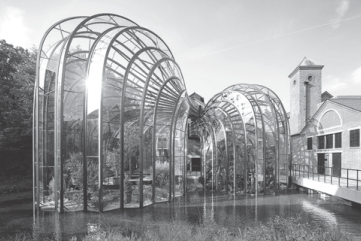Show explores range, imagination of Heatherwick design
By Associated Press In New York ( China Daily ) Updated: 2015-07-04 08:37:38
 |
|
His work includes designing the Bombay Sapphire Distillery and its greenhouses, in Laverstoke, UK.[Iwan Bann/Heatherwick Studio] |
The exhibit looks at 43 projects through prototypes, presentation and sketch models, full-scale mock-ups, objects, photos and video footage.
Born in 1970, Heatherwick studied design before establishing his own studio in 1994. He was inspired by the traditional concept of a master builder, who combined the roles and skills of builder, craftsman, engineer and designer.
His studio consists of over 160 people with "backgrounds in engineering, architecture, product design, landscape architecture, project management, sculpture, photography, theater design, craft and making," Heatherwick wrote in the recently revised and reissued edition of his mammoth book, "Making" (written with Maisie Rowe and published by Monacelli Press).
Each project is approached as the search for an answer to a single guiding question. For the Olympics cauldron: How can every country in the Olympic Games take part in making and lighting the cauldron?
"They tackle everything from furniture and handbags to really major architecture projects with this unique approach to problem solving," Hodge explains. "There is no one-signature style, and every solution is unique."
The studio combines novel engineering with new materials and technology. Its approach first gained international recognition with the 2004 hydraulic "Rolling Bridge" near London's Paddington Station. Designed to be as beautiful when raised as it is when spanning a small channel, the bridge rolls into a geometric snail-like form when not in use. A large working model of it is on view in the show.
Heatherwick's striking new design of the classic London double-decker bus recently took to the streets of the British capital. The show features a pair of seats (with Heatherwick-designed fabric) and a full-scale mock-up of the new bus' rear section (the studio's answer to "Can a London bus be better and use 40 percent less fuel?").
|
|
|
|
|
|
|
|

























 Raymond Zhou:
Raymond Zhou: Pauline D Loh:
Pauline D Loh: Hot Pot
Hot Pot Eco China
Eco China China Dream
China Dream China Face
China Face






